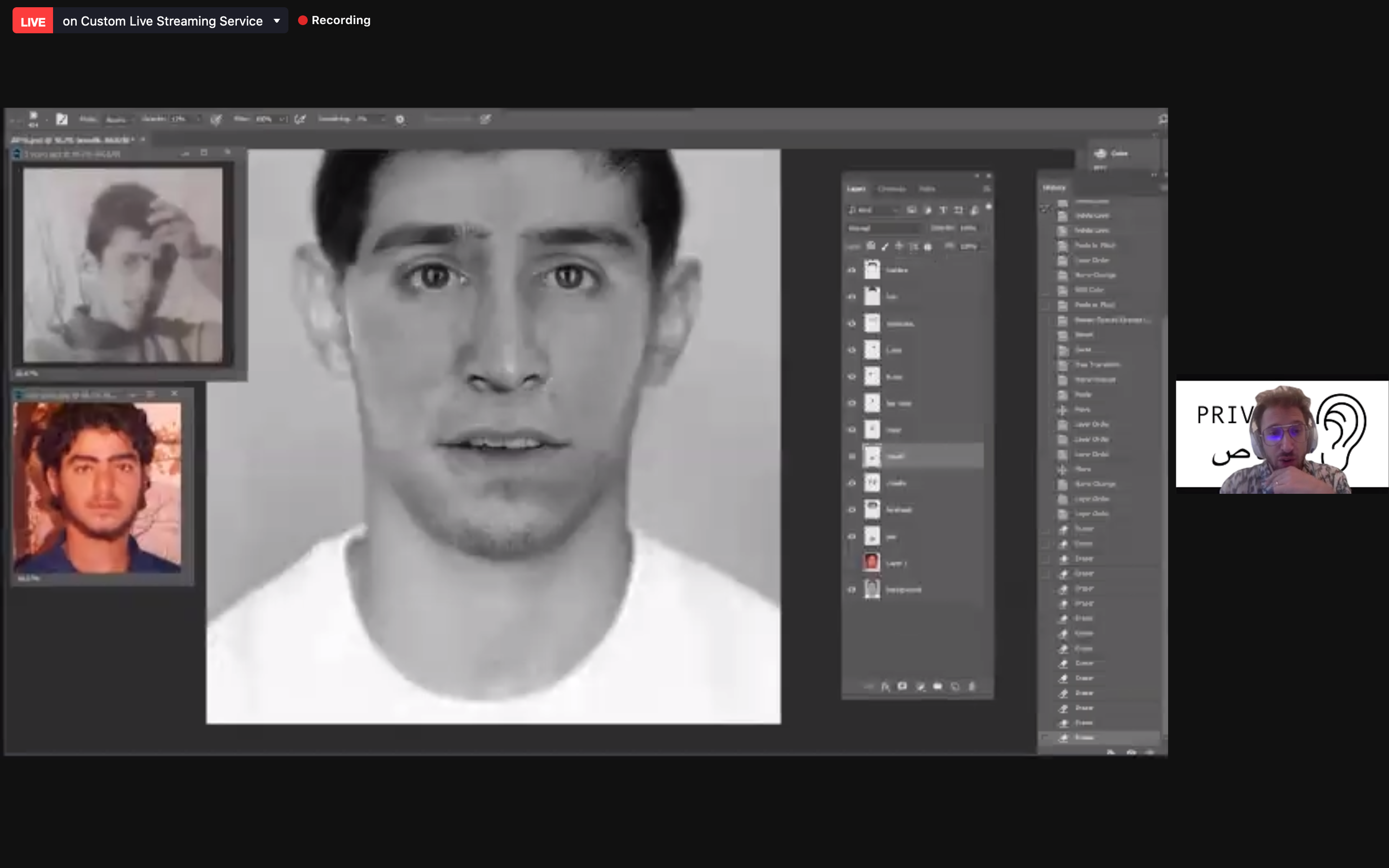ATC Revisited: Lawrence Abu Hamdan

Lawrence Abu Hamdan spoke on Monday, April 05, 2021 at the Art, Technology, and Culture Colloquium at BCNM. Recap from ATC Liaison Jaclyn Tobia.
Last Monday, we had the great pleasure of hosting Lawrence Abu Hamdan for his lecture entitled "The Sonic Image", led by BCNM’s own Tom McEnaney. We were invited to rethink the ways in which sound can act as evidence, without confinement to the logic of visual images. Lawrence Abu Hamdan is a “private ear” whose research and advocacy investigations work at the intersection of politics and sound.
Often collaborating with the people he advocates for, and as a fellow at the research agency Forensic Architecture, his projects are highly resourceful in the pursuit and production of truth.
As a prelude to his discussion of recent projects, Hamdan tells a story about his great Uncle Farhan’s funeral. In his Uncle’s self-published autobiography, he appropriated and stole stories he had heard from the villagers in his community. So, the acoustic temperature of the funeral was quite different than what one would expect. Hamdan describes the chatter as unusually boisterous, as the villagers engaged with gossip about the stolen stories retold. A moment of silence for the casket was preceded by the loud sound of 1,000 plastic chairs scraping across the floor. This screeching sound marked an in between place of conversation and silence. The sound preceded the image of the casket, becoming a marker for the moment in space and time. A sound petrified in memory.
During this anecdote, flashing yellow and red light bulbs appeared from the darkness of our computer screens, recalling the transcriber signals at the Nuremberg Trials. Hamdan explained that these visual cues of light were used to direct participants of the trial to repeat themselves (red), or slow down (yellow), while the stenographer transcribed at the speed of speech. Hamadan discussed the relative proximity of the courtroom stenographer to the content of the trial, and how contemporary transcribers are further away in distance from the stories spatially, but more intimately connected to the content as the pause and rewind button allows for close listening.
Hamdan then gave us an in depth look into two recent projects that explore the concept of a sonic image. In a work from 2012, Hamdan advocated for and collaborated with 11 Somali asylum seekers and activists in the Netherlands. The local government used telephone interviews to determine place of origin, using a type of speech analysis based on accent. The pronunciation of words was used to determine whether an asylum seeker was from a safe zone in Somali, and therefore denied asylum. Mixed accents were considered dishonest. This system, based on arbitrary lines separating north, south, and coastal accents, left many asylum seekers in a perpetual state of precarity and limbo with a deportation order and the inability to return to Somali.
Hamdan and his collaborators rightly argue that the separation of sound on a map with arbitrary lines is a continuation of colonialism and an act of violence. Hamdan’s counter maps argue against the use of language analysis as a birth certificate, and rather seek to convince that the voice is a network, a biography of migration. His imagery shows that sound can’t be dissected by cartographic borders. He does this by visualizing three accents with different qualities of line. Historical events, forced migrations, act as diffusers and filters, creating new types of line. Sound bleeds; an accent traces the past,and is an amalgamation of interactions with every person encountered in someone’s lifetime.
Hamdan’s most recent work, a film entitled “Once Removed”, 2019 follows a cousin who is searching for an image of himself in his past life. After recurring flashbacks to war time days, the cousin realizes that he is the reincarnation of a young soldier named Youssef who died at the age of 16. A religious belief in reincarnation shared by Youssef’s former comrades allows him access to memorabilia from a war that has been hidden by the state. Through a network of former comrades, Hamdan's cousin gains access to Youssef’s uniform, rifle, and memorabilia, but no photographs of Youssef himself. His immediate family only has one blurry photo of Youssef at the age of 6, as he hated to have his picture taken.
With one blurry photo, Hamdan collaborated with a research group in Liverpool to construct a missing person's image of Youssef. Still, there has been no success in matching a photo from his cousin’s archive.
The success of missing person images depends on their ability to be specific yet highly interpretive. Individuality becomes undermined with a belief in reincarnation. Missing person images also undermine individuality, as they must be particular to the story of an individual, but rely on relationships between distinct features to be ambiguous enough to work.
How can an image behave like a sound? Through an exploration of Hamdan’s projects, the sonic image emerges. An image begins to behave like a sound when its meaning is derived from it’s relational qualities. Sound can not be isolated from the space and time in which it resides. Sound is a collaboration between vibration and distinct objects. Sound stays dynamic, changing, and up to interpretation. A sonic image ends the ideology of binaries that vision logic creates.
